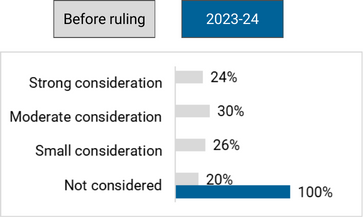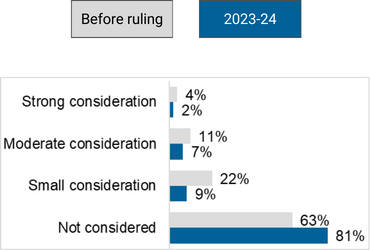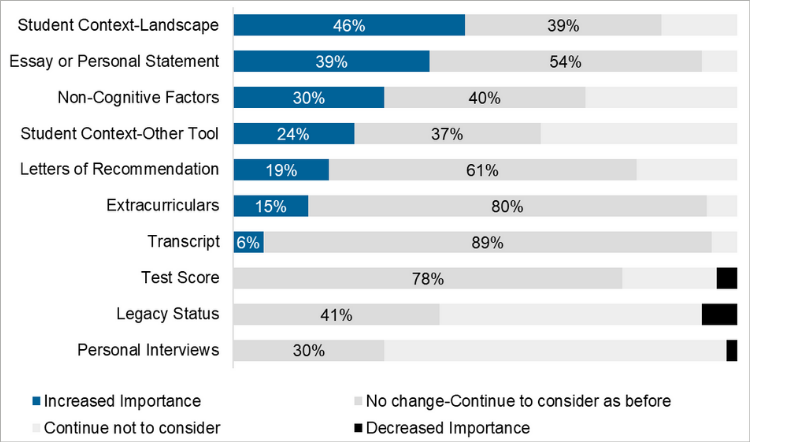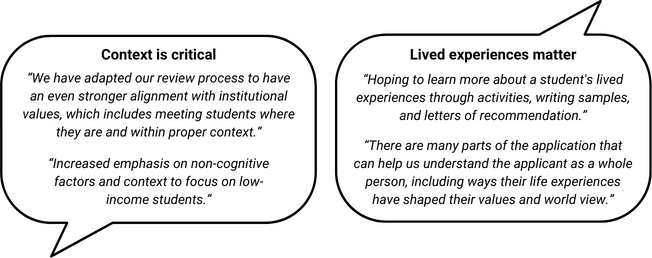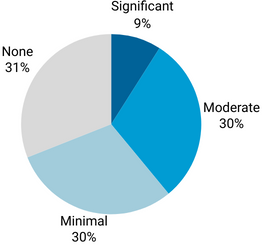Early Insights: How the SCOTUS ruling is impacting admission policy and practice
Survey Overview
Objective:
- Establish a baseline understanding of policy and practice adjustments following the June 2023 Supreme Court decision regarding the consideration of race in admissions.
Methodology & Sample
- Survey was sent to 79 institutions that are sponsors of the ADC, with 55 respondents* (70%). Responses came from a mix of public and private institutions, about 3/4 of which have admit rates less than 50%.
*Given this small sample size, results should be interpreted as directional.
Executive Summary
Following the Supreme Court ruling in the summer of 2023, ADC sponsors identified the need for insights on how their peers were navigating the new legal landscape. To address this, College Board conducted a survey aimed at establishing a baseline understanding of policy and practice changes by ADC sponsor institutions. The survey used a combination of closed- and open-ended questions to address four main topics: 1) Consideration of racial status through the enrollment funnel prior in 2023-24, compared to before the ruling. 2) Changes to applications and admission policies 3) Changes to admission review 4) Changes to communication and other strategies.
Four key themes and takeaways:
The majority of respondents from institutions that previously considered race as a factor in admission, made changes in applications, application review process and rubrics, and training
- 80% of respondents considered racial status as a factor in admission prior to the ruling
- 65% of those that considered race made changes to their application form, 77% changed the importance of at least one criterion, and 91% changed the way they train readers
In 2023-24, institutions continued to look for ways to bring students with diverse backgrounds and experiences to campus
- Most continued to consider racial status in recruitment, with some placing even more emphasis on it
- More than half placed additional emphasis on the consideration of achievement within the context of students' backgrounds and lived experience
While institutions have made changes to their practices, it’s important to note that policies may continue to evolve over time.
- Only 13% of respondents indicated they made admission policy changes this cycle outside of eliminating consideration of racial status.
Institutions are considering a range of strategies to support diversity on their campus
- 96% of respondents said they were considering at least one future change to policy and/or practice to maintain and improve diversity, including shifts in recruitment focus and elimination of legacy consideration
Topic 1: Comparing consideration of racial status through the enrollment funnel
Survey questions:
- To what extent did you consider an applicant’s racial status, prior to the Supreme Court Ruling?
- To what extent do you expect to consider an applicant’s racial status in 2023-24?
Summary of findings:
Admission
Prior to the ruling, racial status was at least a small consideration in admission for 80% of survey respondents. Among public institutions, over half (55%) said they considered racial status prior to the ruling, compared to 91% of private institutions. Not surprisingly, 100% of respondents no longer consider racial status in admission.
Recruitment
For recruitment purposes, most (87%) institutions will continue to consider racial status as at least a small factor in recruitment, with slightly more considering it a strong factor. However, 11% more respondents will not consider race in recruitment this cycle, compared to last.
Financial Aid
Racial status was not an important factor in financial aid and scholarships before the ruling at most institutions, but now over 80% will not consider it at all, a substantial increase compared to the last cycle.
Implications
It is notable that some institutions are choosing to move away from considering racial status in recruitment, although the Court did not address recruitment in its ruling. Multiple legal experts, including our colleagues at EducationCounsel, have clearly stated that well-designed outreach and recruitment programs which incorporate race to build a diverse application pipeline remain permissible. This is an area where institutions can lean in responsibly.
Topic 2: Changes to Applications and Admission Policy
Survey questions:
- Did your institution make any changes to your application form or components for the 2023-24 cycle, as a result of the Supreme Court ruling?
- Did your institution make any changes to admission policies for the 2023-24 cycle, as a result of the Supreme Court Ruling?
Summary of findings:
Application Form Changes
More than half of institutions made application form changes, including 65% of those that considered race prior to the ruling. One in four stopped collecting race/ethnicity. Privates were more likely than publics to make changes—even among publics that previously considered race, only 36% changed application forms.
Admission Policy Changes
Very few (13%) of respondents reported policy changes this cycle, outside of eliminating consideration of racial status.
Implications
The most common change institutions made to application policy and practice was adding or changing essays, presumably in response to the ruling’s caveat that while racial status may not be considered explicitly, institutions may continue to take into account applicants’ “lived experiences”. Responses to questions later in the survey reveal that institutions are focused on training readers to understand how to read essays with new rubrics that support a focus on lived experience and help avoid inference of racial status.
Topic 3: Changes to Admission Review
Survey questions:
- How will the importance of each criterion considered in review change in 2023-24?
- Have readers been trained to review applications differently this cycle?
Summary of findings:
Admission Review Changes
Institutions will place more emphasis than before on factors that help them to get to know applicants’ backgrounds and experiences, including 55% considering student context and/or essays as more important this cycle. 77% of institutions that considered race prior to the ruling will change importance of at least one criterion.
Reader training
91% of institutions that considered race prior to the ruling trained readers to review applications differently for the 2023-24 cycle.
We asked those who reported re-training readers two additional questions:
- What were the key differences emphasized in reader training?
Themes:
- New rubrics for evaluating essays to understand “lived experience” and student fit with the institutional mission
- Guidance/training from general council
- Emphasis on use of context as a lens for all app components, through Landscape and other indicators
- Implicit bias training/how to avoid racial status inference
- New or updated requirements for documenting admission recommendation
What challenges or surprises have you encountered as part of your training efforts?
Themes:
- Difficult to instill confidence in what is allowable to consider
- Hard not to consider racial status (or to ignore, if it’s on a transcript)
- Some surprised at how positively staff responded to learning how to utilize context
- Lack of aggregate race/ethnicity data, or confusion about what data can be seen when, by whom
Implications
Unsurprisingly, the Supreme Court ruling prompted a vast majority of respondents who previously considered racial status during the admissions process to adjust their review practices. Responses indicate that in absence of racial status, there have been substantial, ongoing efforts to re-train readers to consider applicants’ backgrounds and lived experiences as context for their academic achievements and indicators of the diverse perspectives they’d bring to campus.
Topic 4: Communications
Survey question:
- To what extent has the Supreme Court decision influenced communications with families, students, and counselors about your policies and practices?
Summary of findings:
Communications
Though there haven’t been significant changes to communications, nearly 70% of respondents reported that the decision had at least some influence on communications. Some institutions reported being more intentional about addressing their commitment to diversity and acceptance, while others shared that they refreshed guidance on completing their applications.
Communication practice highlights:
- “Given the potential chilling effect of the court's decision, we've proactively been sending affirmative messages to let applicants know they are welcome and will find community on campus.”
- We have created resources to help students and counselors understand our new writing supplements”
- “We did more to describe our supplement question and how to frame a successful answer. Did a Q&A on our web site and a short video.”
- “We made sure to convey the decision itself, reaffirm our values and commitment to diversity, and highlight other key changes in policy and practice.”
Implications
In previous sections of the survey, we learned that many campuses added or changed essays, and adjusted review criteria to place more emphasis on context and lived experiences. Using some of the practices highlighted here, campuses may wish to review and make necessary adjustments to existing guidance for students, families, and counselors on application completion and holistic admission. There may also be an opportunity to assuage student fears that their diverse perspectives will no longer be considered or valued.
Topic 5: Future Strategies
Survey questions:
- To what extent are you considering the following changes to strategy, policy, and practice?
Summary of findings:
Following the ruling, ADC institutions are considering a range of strategies to continue to advance access and diversity on their campuses. Nearly all (96%) of respondents said they were considering at least one of these changes.
Implications
Many institutions will focus on supporting access and diversity efforts through recruitment, looking to identify new feeder high schools and community college partnerships. Neither of these new sources will be successful without significant effort-- cultivating new feeder high schools will require staff resources and personalized outreach, as well as ample data to help identify the schools and provide context for applicants’ credentials (which many institutions also report seeking). Community Colleges are a source for what we know is a large and diverse cohort of potential transfer students but enrolling them at scale will demand significant cross-campus efforts to ensure their success.
Conclusion
These early insights from ADC sponsors showcase some strategies institutions may consider implementing while navigating this new legal landscape. The ADC will continue to explore how institutions adjust their policies, practices, and processes because of the ruling, and work with our sponsors to develop resources that provide guidance on best practices. Every institution is unique, and what proves effective for some may not work for others. It’s important for institutions to confer with their legal counsel to ensure they operate within the confines of the law.
